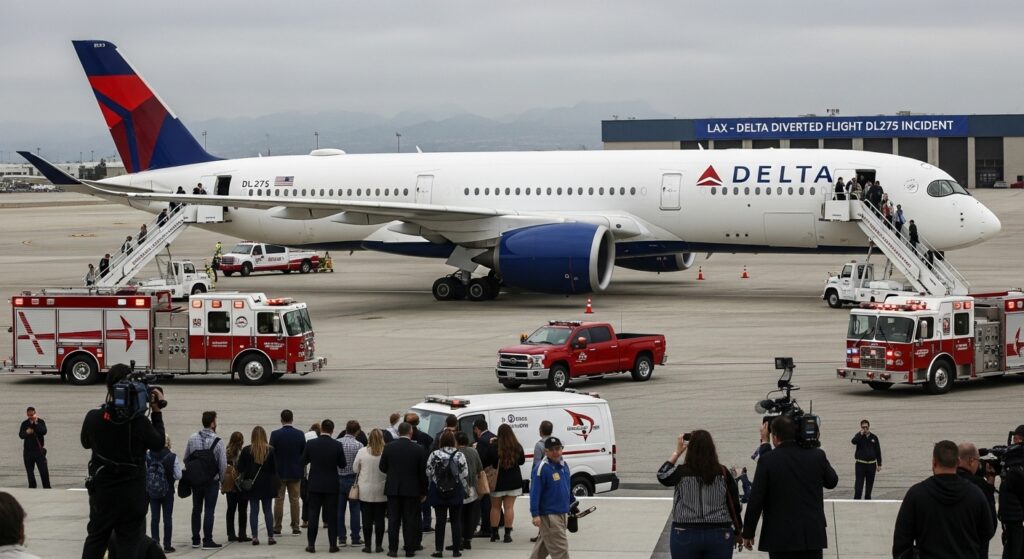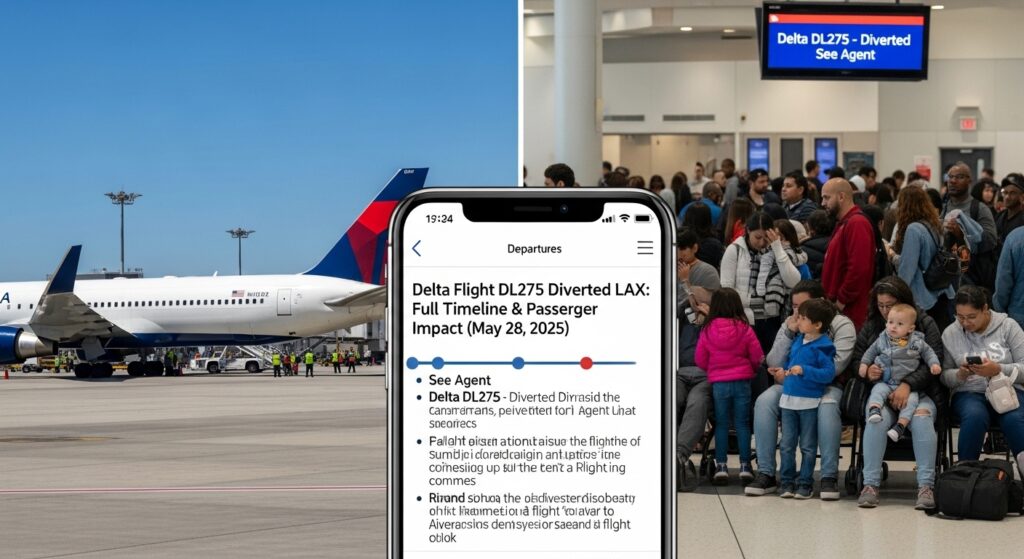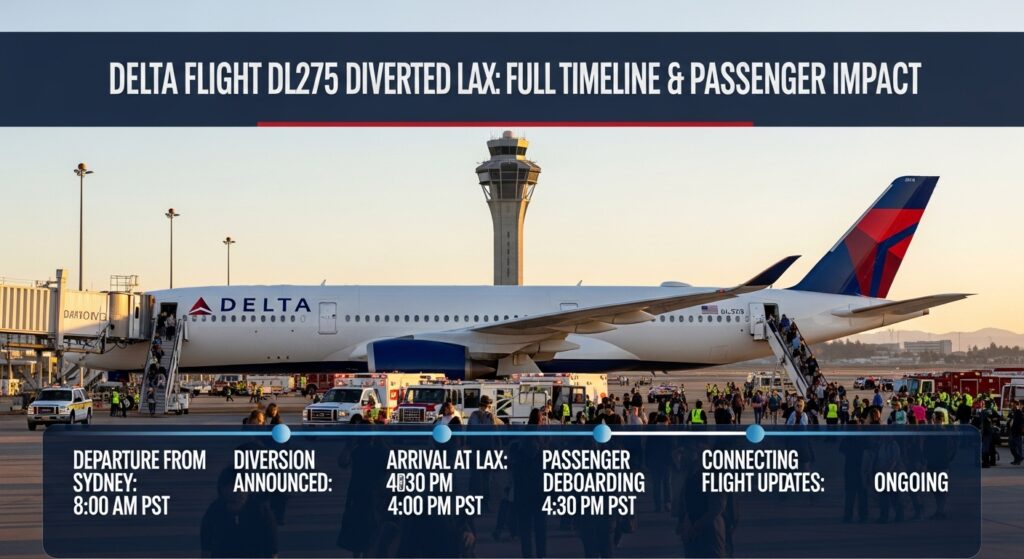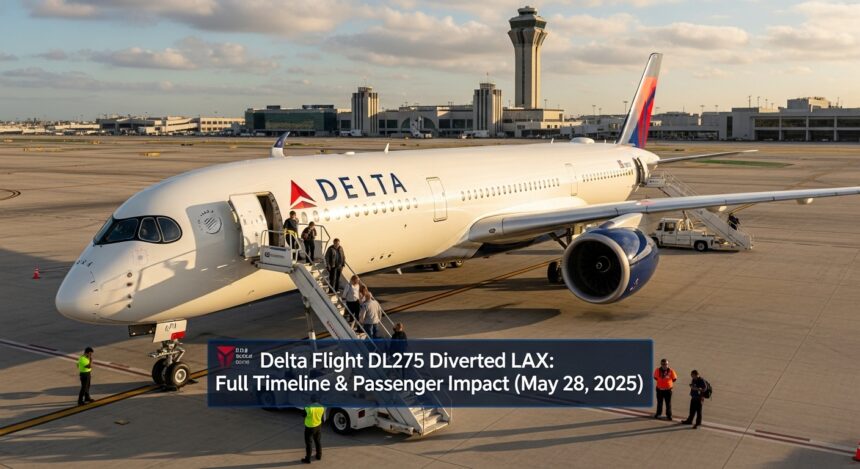Table of Contents
When a flight takes an unexpected turn, it grabs attention. Delta Flight DL275, a routine journey from Detroit to Tokyo, became a headline when it diverted to Los Angeles International Airport (LAX) on May 28, 2025, due to a technical issue, leaving passengers and aviation enthusiasts buzzing with questions.
This article dives into the details of why Delta Flight DL275 diverted LAX, what happened on board, and how the airline handled the situation. From the reasons behind the diversion to passenger experiences and safety protocols, we’ll break it all down in simple terms. Whether you’re curious about aviation safety or planning a trip, here’s everything you need to know about this high-profile incident.
The Unexpected Turn in the Skies
Delta Flight DL275 was cruising over the North Pacific when the crew made a critical decision. The Airbus A350-900, carrying 287 passengers, turned back toward Los Angeles instead of continuing to Tokyo.
- Flight Path Shift: The plane was 620 nautical miles southwest of Anchorage when the crew noticed an issue.
- Quick Decision: Instead of risking a long journey over the ocean, they chose LAX, a major Delta hub.
This sudden change sparked curiosity and concern among passengers. Social media lit up with real-time updates as travelers shared their experiences.
Why the Plane Changed Course

The diversion of Delta Flight DL275 to LAX was triggered by a malfunction in the aircraft’s anti-ice system. This system is vital for preventing ice buildup on the engines during high-altitude flights over cold regions.
- Technical Issue: The Rolls-Royce Trent XWB engine’s anti-ice system failed, posing a safety risk.
- Safety First: The crew decided to divert to avoid potential engine thrust loss over the Pacific.
Such issues, while rare, highlight the importance of quick thinking in aviation. The choice to reroute was a precaution to ensure everyone’s safety.
A Closer Look at the Aircraft
The plane involved was an Airbus A350-900, registered as N508DN. This modern aircraft is known for its reliability and passenger comfort.
- Age and Design: The 7-year-old jet is part of Delta’s fleet of 37 A350s, designed for long-haul routes.
- Comfort Features: Passengers enjoy spacious cabins and advanced technology on this model.
Despite its advanced systems, even the best planes can face unexpected challenges. The A350’s robust design helped it land safely despite the issue.
How the Crew Handled the Situation
The flight crew’s professionalism was key to managing the diversion. Their training kicked in, ensuring a calm and controlled response.
- Clear Communication: The captain informed passengers about the change, keeping everyone in the loop.
- Coordinated Effort: The crew worked with air traffic control to secure a safe landing at LAX.
Passengers praised the staff for their calm demeanor. One traveler noted on social media that the crew’s transparency eased their worries.
Passenger Experiences During the Diversion
Onboard, emotions ranged from confusion to relief. The 12-hour flight, which ended at LAX instead of Tokyo, was an emotional rollercoaster for many.
- Initial Shock: Passengers were surprised when the pilot announced the diversion mid-flight.
- Mixed Feelings: Some felt anxious, while others appreciated the focus on safety.
One passenger shared on Reddit that seeing emergency vehicles on the runway at LAX was both unsettling and reassuring. The crew’s updates helped keep the cabin calm.
Why Los Angeles Was the Best Choice
Choosing LAX as the diversion airport wasn’t random. It was a strategic decision based on several factors.
- Major Hub: LAX is a key Delta hub with maintenance facilities and spare parts for the A350.
- Support Systems: The airport has certified technicians and robust passenger services.
This choice ensured the plane could be inspected and passengers rebooked efficiently. LAX’s infrastructure made it the safest and most practical option.
The Financial Impact of the Diversion
Diverting a long-haul flight like DL275 comes with a hefty price tag. The incident cost Delta an estimated $2.3 million.
- Direct Costs: Fuel, maintenance, and passenger accommodations added up quickly.
- Ripple Effects: Cancelled Tokyo connections disrupted Delta’s Pacific operations for days.
These costs highlight the complexity of managing such incidents. Airlines prioritize safety, even when it’s expensive.
Safety Protocols in Action

Aviation safety protocols were on full display during this incident. Delta’s response showcased why air travel remains one of the safest ways to get around.
- Early Detection: The aircraft’s systems flagged the anti-ice issue before it became critical.
- Trained Crew: Pilots followed strict procedures to ensure a safe landing.
This event is now a case study in crew training programs. It shows how preparation can prevent worse outcomes.
How Delta Supported Passengers
After landing at LAX, Delta moved quickly to assist the 287 passengers. The airline’s response was praised by many.
- Rebooking Options: Most passengers were placed on alternative flights to Tokyo or other destinations.
- Accommodations: Delta provided meals, lodging, and transportation vouchers for those delayed overnight.
Social media posts highlighted the staff’s efforts to keep travelers informed. One passenger tweeted gratitude for the clear updates and support.
Lessons for the Aviation Industry
The DL275 diversion offers valuable insights for airlines worldwide. It underscores the need for advanced technology and training.
- Predictive Maintenance: AI systems could have detected the anti-ice issue before takeoff.
- Crew Readiness: Ongoing training ensures crews can handle emergencies calmly.
This incident will likely influence future safety protocols. Airlines are already exploring AI to prevent similar issues.
The Role of Technology in Preventing Issues
Modern aircraft rely on sophisticated systems to monitor performance. The DL275 incident shows both the strengths and gaps in current technology.
- Real-Time Monitoring: Sensors caught the anti-ice failure early, allowing the crew to act.
- Room for Improvement: AI predictive tools could reduce such incidents by up to 94%.
Delta is investing in smarter monitoring systems. These advancements could make diversions even rarer.
Passenger Reactions and Social Media Buzz
Social media played a big role in spreading news about the diversion. Passengers and aviation fans shared updates in real-time.
- Reddit Threads: Users discussed the event, praising the crew’s handling of the situation.
- Live Tracking: Apps like FlightRadar24 let people follow the plane’s path online.
One Reddit user described the experience as “surreal but well-managed.” These posts gave the public a glimpse into the event as it unfolded.
The Bigger Picture of Flight Diversions
Diversions like DL275’s are rare but not unheard of. They remind us that safety always comes first in aviation.
- Common Reasons: Mechanical issues, medical emergencies, or weather can prompt diversions.
- Global Impact: Diversions cost the industry billions annually, but they save lives.
The DL275 case shows how airlines balance safety and efficiency. It’s a complex process that prioritizes passengers.
What Passengers Can Expect After a Diversion

If you’re ever on a diverted flight, here’s what might happen. Delta’s response to DL275 offers a good example.
- Immediate Support: Airlines provide food, lodging, or rebooking options.
- Clear Updates: Crews and staff keep you informed about next steps.
Travelers on DL275 appreciated the quick assistance. Knowing what to expect can ease the stress of unexpected changes.
How to Stay Prepared as a Traveler
Unexpected events like diversions can disrupt travel plans. Being prepared can make a big difference.
- Check Flight Status: Use apps like FlightRadar24 to track your flight in real-time.
- Know Your Rights: Airlines often offer compensation or support for delays.
One DL275 passenger used the Delta app to rebook their flight quickly. Staying informed helps you navigate disruptions smoothly.
Final Thoughts
The diversion of Delta Flight DL275 diverted LAX on May 28, 2025, was a dramatic reminder of aviation’s focus on safety. A malfunction in the Airbus A350’s anti-ice system led to a 12-hour journey ending in Los Angeles instead of Tokyo. The crew’s quick thinking, Delta’s efficient response, and LAX’s robust facilities ensured all 287 passengers landed safely and were well cared for.
This incident highlights the importance of preparation, from crew training to advanced technology. While diversions can be inconvenient, they show how seriously airlines take passenger safety. Next time you fly, check your flight status and stay informed it could make all the difference. For more details on Delta’s services or flight updates, visit their official website or track flights on platforms like FlightRadar24.
FAQs
Why did Delta Flight DL275 divert to LAX?
Delta Flight DL275, traveling from Detroit to Tokyo on May 28, 2025, diverted to Los Angeles due to a malfunction in the Airbus A350’s anti-ice system. The precautionary decision was made to ensure passenger safety.
What happened to the passengers after landing at LAX?
After the safe landing, Delta provided hotel accommodations, meal vouchers, and rebooking assistance. Most passengers were rebooked on later flights to Tokyo or alternative routes.
What type of aircraft was used for Delta Flight DL275?
The flight was operated by an Airbus A350-900, registered as N508DN. This is one of Delta’s flagship long-haul aircraft, known for advanced safety systems and passenger comfort.
Are flight diversions like DL275 common?
Diversions are not very common but they do occur occasionally in aviation, usually due to technical issues, medical emergencies, or severe weather. They are an important safety measure rather than a failure of the system








